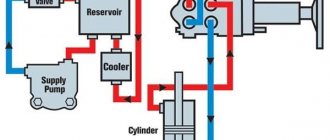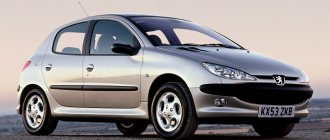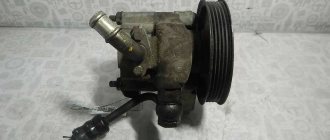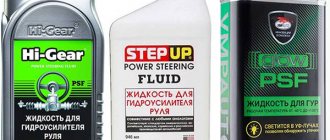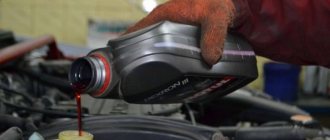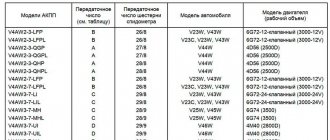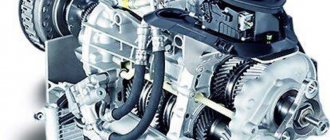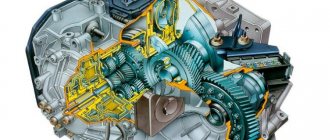The operating principle of automatic transmission and power steering is based on the operation of fluids, such as ATF Dexron 3. Lubricants from different manufacturers are sold with a similar name. Oils vary in composition, characteristics and performance. Familiarization with the Dextron specification will help you navigate the diversity and choose the best product.
What is Dexron
With the development of the automotive industry in the mid-20th century, standards for automatic transmission oil began to appear. The fluid is called Automatic Transmission Fluid - ATF. The standard described the requirements for fluid composition based on the design features of the gearbox.
General Motors (GM) has been more successful in development than others. The first fluid suitable for all automatic transmissions, Type A fluid, appeared in 1949. After 8 years the specification was updated under the name Type A Suffix A.
In 1967, GM developed the technical standard ATF Dexron type B. The automatic transmission fluid consisted of a stable, hydrotreated base and received anti-foam additives, high heat resistance, and anti-oxidation. The mileage guarantee between replacements was 24,000 miles. The oil was colored red to make it easier to detect leaks.
Sperm whale spermaceti substance was used as friction additives for the first fluids. In 1973, Dexron type II C replaced it with jojoba oil, but the automatic transmission parts quickly rusted. After the problem was discovered, corrosion inhibitors were added to the next generation, Dextron II D, but the automatic transmission fluid quickly aged due to its high hygroscopicity.
By 1990, the automatic transmission became electronically controlled, which required a revision of the specifications. This is how Dextron II E was born. In addition to adding new additives, the base changed from mineral to synthetic:
- viscosity improved;
- the operating temperature range has expanded;
- increased resistance to oil film rupture;
- the durability of the liquid has increased.
In 1993, the Dextron IIIF standard was released. This type of oil had high viscosity and friction properties.
Read
Toyota ATF Type T IV transmission oil
ATF Dexron IIIG appeared in 1998. New oil requirements solved the problems with automatic transmission torque converter vibrations. ATP began to be used in power steering, hydraulic systems and air compressors where low-temperature fluidity is required.
In 2003, with the release of ATP Dextron IIIH, the additive package was updated: friction modifier, anti-corrosion, anti-foam. The oil has become more durable. The fluid is suitable for automatic transmissions with and without an adjustable torque converter lock-up clutch.
All licenses for Dextron IIIH expired in 2011, but companies under this standard continue to release their products.
Changing power steering oil - description of the process
Replacing the lubricant in the power steering is a rather painstaking task; you should take the procedure seriously and follow the instructions.
Adding fluid
To add oil, it is recommended to purchase Multi HF universal fluid, since it can be mixed with absolutely any lubricant.
Instructions for adding hydraulic lubricant to the power steering:
- Inspect the power steering reservoir and mechanism for leaks. If there are any, they need to be eliminated;
- Check the hydraulic oil level in the power steering reservoir;
- After removing the plug, add fluid to about;
- Start the engine and turn the steering wheel from the extreme left to the extreme right;
- Check the lubricant level in the power steering reservoir and, if necessary, top up to about.
Complete fluid change
A complete lubricant change requires great perseverance and coordination. Hydraulic oil must be selected based on the manufacturer’s recommendations.
- Hang up the car. This is done to facilitate rotation of the steering wheel when the engine is off;
- We will need a syringe - we need to pump out all the fluid from the power steering reservoir;
- Then loosen the clamps on the hoses, remove them from the tank, rinse the container itself thoroughly;
- Direct the return line (steering rack hose) into an empty jar - the liquid remaining in the rack will drain there;
- By turning the steering wheel, remove any remaining lubricant from the mechanism. It is required to make quite intense and prolonged movements with the steering wheel;
- After the hydraulic oil stops leaking, you need to fill (rinse) the rack with freshly purchased fluid. To do this, insert a funnel into the second hose and fill it to capacity;
- After this, we repeat the manipulations with the steering wheel again. When all the oil has flowed out of the return hose, the procedure can be completed;
- Then reassemble the hydraulic power steering system in reverse order;
- Fill the mechanism reservoir with oil according to the level;
- After the system is filled, you need to turn the steering wheel from the extreme left position to the extreme right. Such manipulations should be carried out with the engine running;
- We turn off the engine, lower the car, check the tightness of the connections, and add fluid to the amplifier tank to the maximum.
This is interesting: How to train the throttle valve of a Nissan Almera Classic Belt-
driven power steering pump
Application area
ATF Dextron was originally developed for automatic transmissions. Oil in an automatic transmission performs different functions: transmits torque, creates pressure on the clutches and guarantees proper friction, lubricates parts, protects against corrosion, and removes heat. When choosing ATP, you need to check the product for the Dextron specification.
Dextron specifications indicate the optimal viscosity index for each type of ATP. High viscosity oils increase the slippage of friction discs and increase wear on the rubbing parts of automatic transmissions. With low viscosity, the protective film on bearings and gears is thin and breaks quickly. Bullies appear. The seals are deformed. Automatic transmission fluid is leaking.
The operating viscosity of ATF Dexron III H is in the range of 7 - 7.5 cSt at 100℃. This indicator guarantees that Dextron 3 oil in automatic transmissions will last a long time without replacement, maintaining its performance properties.
ATF Dexron III H is used in 4 and 5-speed automatic transmissions manufactured before 2006. The boxes are installed in cars, commercial vehicles, and buses.
With the expansion of the functionality of the transmission fluid, the scope of application has also increased:
- hydraulic systems: power steering, hydrostatic transmission, hydraulic drive, hydropneumatic suspension, hydraulic brake system;
- gearboxes for construction, agricultural and mining equipment;
- industrial equipment.
The requirements for power steering oil are similar to those of automatic transmissions, so Opel, Toyota, Kia, Geely allow the use of ATF Dexron in the hydraulic booster. BMW, VAG, Renault, Ford recommend pouring a special power steering fluid - PSF, CHF.
The use of ATP Dextron is divided into climatic zones:
- for regions with winter temperatures down to -15℃, Dextron II D is suitable;
- with temperatures up to -30℃ - Dextron II E;
- with temperatures up to -40℃ - Dextron III H.
Read
Full and partial oil change in automatic transmission Honda Accord 7
What is better for power steering: mineral oils or synthetics
The long-standing debate about which is better - synthetic or mineral water for the power steering system is not appropriate. The fact is that in the power steering there are a lot of rubber parts like nowhere else. Synthetic oils have a worse effect on the life of rubber parts based on natural rubber (almost all types of rubber), due to their chemical aggressiveness. In order to fill synthetic oils into the power steering system, its rubber parts must be designed for synthetic oils and have a special composition.
Power steering fluid (oil)
Rare cars use synthetic oils for power steering! But synthetic oils are often used in automatic transmissions. Fill the power steering system only with mineral water, unless the instructions specifically indicate synthetic oil!
Operating conditions for Dextron transmission fluids
The service life of ATF Dexron depends not only on the mileage, but also on the operating conditions of the machine:
- with aggressive driving, frequent slipping, driving on broken roads, ATF Dexron II and III wear out quickly;
- starting without warming up the automatic transmission oil in winter leads to rapid aging of Dexron 2 and 3;
- due to underfilling of fluid in the box, the pressure drops, the performance properties of the automatic transmission oil are reduced;
- the overflow of ATP causes the emulsion to foam. The excess splashes out, and the automatic transmission becomes underfilled with fluid;
- Constant overheating of the oil above 90℃ leads to loss of performance.
Manufacturers select ATP based on viscosity, load tolerance, friction properties, etc. for reliable operation of the waterworks. The marking for the recommended oil type, for example ATF Dexron II G or ATF Dexron III H, is indicated on the design:
- on automatic transmission oil dipsticks;
- on the plate under the hood;
- on the label of the power steering reservoirs.
The manufacturer's recommendations must be followed. This is what will happen if you ignore the instructions:
- Gears in the automatic transmission will shift with a delay. In newly filled liquid, frictional friction parameters may be underestimated or overestimated. The discs will slip at a different speed. Hence the increased consumption of ATF Dexron and wear of the clutches
- Loss of smoothness of gear shifting in automatic transmission. Changing the proportion and composition of additives leads to improper operation of the oil pump. Pressure will be supplied to the automatic transmission mechanisms with a delay.
- Pouring synthetic ATP Dextron into the power steering instead of the recommended mineral one will lead to wear of the rubber seals. In power steering with synthetic oil, the rubber composition differs in the presence of silicone and other additives.
How to top up
The process of topping up is simple - you need to unscrew the cap of the power steering expansion tank and add enough fluid so that it is between the MIN and MAX marks.
The main problem when adding power steering oil is its choice. It’s good if the replacement has not yet been made, and the system contains fluid from the manufacturer’s factory. In this case, it is enough to check the technical documentation, take the recommended oil and add to the required amount.
» alt=»»> If you don’t know what’s in the system, we recommend replacing it right away, because in any case you’ll have to buy a canister of liquid to top it up.
Source
Release forms and articles
Synthetic-based ATP is made from hydrocracked petroleum fractions. The composition also contains polyesters, alcohols, additives that guarantee stability at operating temperatures, a dense oil film and long service life.
Read
Original oil and analogues for Honda automatic transmissions
Semi-synthetic fluids contain a mixture of synthetic and mineral oils. They are characterized by good fluidity, anti-foaming and heat dissipation.
Mineral oils consist of 90% petroleum fractions, 10% additives. These fluids are inexpensive, but their service life is short.
The most common Dextrons with release forms and articles:
- Motul ATF Dexron 3:
- 1 l, art. 105776;
- 2 l, art. 100318;
- 5 l, art. 106468;
- 20 l, art. 103993;
- 60 l, art. 100320;
- 208 l, art. 100322.
- Mobil ATF 320, semi-synthetic:
- 1 l, art. 152646;
- 20 l, art. 146409;
- 208 l, art. 146408.
- ZIC ATF 3, synthetic:
- 1 l, art. 132632.
- Liqui Moly ATF Dexron II D, mineral:
- 20 l, art. 4424;
- 205 l, art. 4430.
- Febi ATF Dexron II D, synthetic:
- 1 l, art. 08971.
Dextron can be of any of three types in composition. Volumes up to 5 liters are available in plastic cans or bottles. 200 l are supplied in metal barrels.
What kind of fluid to pour into the power steering
Based on this, the answer to the question “what kind of oil to pour into the power steering” is obvious - recommended by the manufacturer of your car. Often information is indicated on the expansion tank or cap. If there is no technical documentation, call an authorized center and ask.
In any case, experiments with steering are unacceptable. Not only your safety, but also that of those around you depends on the health of your power steering.
| car model | Recommended liquid |
| Audi 80, 100 (audi 80, 100) | VAG G 004 000 M2 |
| Audi A6 C5 (audi a6 c5) | Mannol 004000, Pentosin CHF 11S |
| Audi a4 (audi a4) | VAG G 004 000M2 |
| Audi a6 c6 (audi a6 c6) | VAG G 004 000M2 |
| BMW e34 (BMW e34) | CHF 11.S |
| BMW E39 (BMW E39) | ATF Dextron 3 |
| BMW E46 (BMW E46) | Dexron III, Mobil 320, LIQUI MOLY ATF 110 |
| BMW E60 (BMW E60) | Pentosin chf 11s |
| BMW x5 e53 (BMW x5 e53) | ATF BMW 81 22 9 400 272, Castrol Dex III, Pentosin CHF 11S |
| VAZ 2110 | Pentosin Hydraulic Fluid (CHF,11S-tl, VW52137) |
| VAZ 2112 | Pentosin Hydraulic Fluid (CHF,11S-tl, VW52137) |
| Volvo s40 (volvo s40) | Volvo 30741424 |
| Volvo xc90 (volvo xc90) | VOLVO 30741424 |
| Gas (Valdai, Sobol, 31105, 3110, 66) | Mobil ATF 320, Castrol-3, Liqui moly ATF, DEXTRON III, CASTROL Transmax Dex III Multivehicle, ZIC ATF III, ZIC dexron 3 ATF, ELF matic 3 |
| Gazelle business | Mobil ATF 320, Castrol-3, Liqui moly ATF, DEXTRON III, CASTROL Transmax Dex III Multivehicle, ZIC ATF III, ZIC dexron 3 ATF, ELF matic 3 |
| Gazelle next | Shell Spirax S4 ATF HDX, Dexron III |
| Geely MK | ATF DEXRON III, Shell Spirax S4 ATF X, Shell Spirax S4 ATF HDX |
| Geely Emgrand | ATF DEXRON III, Shell Spirax S4 ATF X, Shell Spirax S4 ATF HDX |
| Dodge Stratus | ATF+4, Mitsubishi DiaQueen PSF, Mobil ATF 320 |
| Daewoo Gentra | Dexron-IID |
| Daewoo matiz | Dexron II, Dexron III |
| Daewoo Nexia | Dexron II, Dexron III, Top Tec ATF 1200 |
| Zaz chance | LiquiMoly Top Tec ATF 1100, ATF Dexron III |
| Zil 130 | T22, T30, Dexron II |
| Zyl bull | AU (MG-22A), Dexron III |
| Kamaz 4308 | TU 38.1011282-89, Dexron III, Dexron II, GIPOL-RS |
| Kia Carens | Hyundai Ultra PSF-3 |
| Kia rio 3 (Kia rio 3) | PSF-3, PSF-4 |
| Kia Sorento | Hyundai Ultra PSF-III, PSF-4 |
| Kia Spectra | Hyundai Ultra PSF-III, PSF-4 |
| Kia Sportage | Hyundai Ultra PSF-III, PSF-4 |
| Kia Cerato | Hyundai Ultra PSF-III, PSF-4 |
| Chrysler PT Cruiser | Mopar ATF 4+ (5013457AA) |
| Chrysler Sebring | Mopar ATF+4 |
| Lada Largus | Mobil ATF 52475 |
| Lada Priora | Pentosin Hydraulik Fluid CHF 11S-TL VW52137, Mannol CHF |
| Land Rover Freelander 2 | LR003401 pas fluid |
| Lifan smiley (lifan smily) | Dexron III |
| Lifan solano | Dexron II, Dexron III |
| Lifan X60 (lifan x60) | Dexron III |
| Maz | BRAND R (Oil MG-22-V) |
| Mazda 3 | Mazda M-3 ATF, Dexron III |
| Mazda 6 (mazda 6 GG) | Mazda ATF MV, Dexron III |
| Mazda cx7 (Mazda cx7) | Motul Dexron III, Mobil ATF320, Idemitsu PSF |
| Man 9 (Man) | MAN 339Z1 |
| Mercedes w124 (mercedes w124) | Dexron III, Febi 08972 |
| Mercedes w164 (mercedes w164) | A000 989 88 03 |
| Mercedes w210 (mercedes w210) | A0009898803, Febi 08972, Fuchs Titan PSF |
| Mercedes w211 (mercedes w211) | A001 989 24 03 |
| Mercedes Actros | Pentosin CHF 11S |
| Mercedes atego (mercedes atego) | Dexron III, Top Tec ATF 1100, MV 236.3 |
| Mercedes ML (mercedes ml) | A00098988031, Dexron IID, MB 236.3, Motul Multi ATF |
| Mercedes sprinter | Dexron III |
| Mitsubishi Outlander | Dia Queen PSF, Mobil ATF 320 |
| Mitsubishi Galant | Mitsubishi Dia Queen PSF, Mobil ATF 320, Motul DEXRON III |
| Mitsubishi Lancer 9, 10 (Mitsubishi Lancer) | Dia Queen PSF, Mobil ATF 320, Dexron III |
| Mitsubishi Montero Sport | Dexron III |
| Mitsubishi Pajero | Dia Queen PSF, Mobil ATF 320 |
| Mitsubishi Pajero 4 | Dia Queen PSF, Mobil ATF 320 |
| Mitsubishi Pajero Sport | Dia Queen PSF, Mobil ATF 320 |
| Mtz 82 | in summer M10G2, M10V2, in winter M8G2, M8V2 |
| Nissan Avenir | Dexron II, Dexron III, Dex III, Castrol Transmax Dex III Multivehicle |
| Nissan ad | NISSAN KE909-99931 "PSF |
| Nissan Almera | Dexron III |
| Nissan Murano | KE909-99931 PSF |
| Nissan Primera | ATF320 Dextron III |
| Nissan Teana J31 (Nissan Teana J31) | Nissan PSF KLF50-00001, Dexron III, Dexron VI |
| Nissan Cefiro | Dexron II, Dexron III |
| Nissan Pathfinder | KE909-99931 PSF |
| Opel Antara | GM Dexron VI |
| Opel Astra H (opel astra H) EGR | OPEL PSF 19 40 715, SWAG 99906161, FEBI-06161 |
| Opel Astra J | Dexron VI, General Motors 93165414 |
| Opel Vectra A | Dexron VI |
| Opel Vectra B | GM 1940771, Dexron II, Dexron III |
| Opel Mokka | ATF DEXRON VI" Opel 19 40 184 |
| Peugeot 206 | Total Fluide AT42, Total Fluide LDS |
| Peugeot 306 | Total Fluide DA, Total Fluide LDS |
| Peugeot 307 | Total Fluid DA |
| Peugeot 308 | Total Fluid DA |
| Peugeot 406 | Total Fluide AT42, GM DEXRON-III |
| Peugeot 408 | Total FLUIDE AT42, PENTOSIN CHF11S, Total FLUIDE DA |
| Peugeot partner | Total Fluide AT42, Total Fluide DA |
| Ravon Gentra | Dexron 2D |
| Renault duster | ELF ELFMATIC G3, ELF RENAULTMATIC D3, Mobil ATF 32 |
| Renault Laguna | ELF RENAULT MATIC D2, Mobil ATF 220, Total FLUIDE DA |
| Renault Logan | Elf Renaultmatic D3, Elf Matic G3 |
| Renault Sandero | ELF RENAULTMATIC D3 |
| Renault simbol | ELF RENAULT MATIC D2 |
| Citroen Berlingo | TOTAL FLUIDE ATX, TOTAL FLUIDE LDS |
| Citroen C4 (Citroen C4) | Total Fluide DA, TOTAL FLUIDE LDS, Total Fluide AT42 |
| Scania | ATF Dexron II |
| SsangYong New Actyon | ATF Dexron II, Total Fluide DA, Shell LHM-S |
| SsangYong Kyron | Total Fluide DA, Shell LHM-S |
| Subaru Impreza | Dexron III |
| Subaru Forester | ATF DEXTRON IIE, III, PSF Fluid Subaru K0515-YA000 |
| Suzuki Grand Vitara | Mobil ATF 320, Pentosin CHF 11S, Suzuki ATF 3317 |
| Suzuki Liana | Dexron II, Dexron III, CASTROL ATF DEX II multivehicle, RYMCO, Liqui Moly Top Tec ATF 1100 |
| Tata (truck) | Dexron II, Dexron III |
| Toyota Avensis | 08886-01206 |
| Toyota Carina | Dexron II, Dexron III |
| Toyota Corolla (Toyota Hiace) | Dexron II, Dexron III |
| Toyota Land Cruiser Prado 120 (Toyota Land Cruiser 120) | 08886-01115, PSF NEW-W, Dexron III |
| Toyota Land Cruiser Prado 150 (Toyota Land Cruiser 150) | 08886-80506 |
| Toyota Land Cruiser Prado 200 (Toyota Land Cruiser 200) | PSF NEW-W |
| Toyota Hiace | Toyota ATF DEXTRON III |
| Toyota Chaser | Dexron III |
| UAZ loaf | Dexron II, Dexron III |
| UAZ patriot, hunter | Mobil ATF 220 |
| Fiat Albea | DEXRON III, ENEOS ATF-III, Tutela Gi/E |
| Fiat Doblo | Spirax S4 ATF HDX, Spirax S4 ATF X |
| Fiat Ducato | TUTELA GI/A ATF DEXRON 2 D LEV SAE10W |
| Volkswagen Vento | VW G002000, Dexron III |
| Volkswagen Golf 3 | G002000, Febi 6162 |
| Volkswagen Golf 4 | G002000, Febi 6162 |
| Volkswagen Passat B3 | G002000, VAG G004000M2, Febi 6162 |
| Volkswagen Passat B5 (Volkswagen passat B5) | VAG G004000M2 |
| Volkswagen Transporter T4, T5 (Volkswagen Transporter) | VAG G 004 000 M2 Power Steering Fluid G004, Febi 06161 |
| Volkswagen Touareg | VAG G 004 000 |
| Ford Mondeo 3 (ford mondeo 3) | FORD ESP-M2C-166-H |
| Ford Mondeo 4 | WSA-M2C195-A |
| Ford transit | WSA-M2C195-A |
| Ford Fiesta | Mercon V |
| Ford Focus 1 | Ford WSA-M2C195-A, Mercon LV Automatic, FORD C-ML5, Ravenol PSF, Castrol Transmax Dex III, Dexron III |
| Ford Focus 2 | WSS-M2C204-A2, WSA-M2C195-A |
| Ford Focus 3 | Ford WSA-M2C195-A, Ravenol Hydraulik PSF Fluid |
| Ford Fusion | Ford DP-PS, Mobil ATF 320, ATF Dexron III, Top Tec ATF 1100 |
| Hyundai Accent | RAVENOL PSF Power Steering Fluid, DEXRON III |
| Hyundai Getz | ATF SHC |
| Hyundai Matrix | PSF-4 |
| Hyundai SantaFe | Hyundai PSF-3, PSF-4 |
| Hyundai Solaris | PSF-3, Dexron III, Dexron VI |
| Hyundai Sonata | PSF-3 |
| Hyundai Tucson/Tucson | PSF-4 |
| Honda accord 7 | PSF-S |
| Honda Odyssey | Honda PSF, PSF-S |
| Honda HRV | Honda PSF-S |
| Chery amulet | BP Autran DX III |
| Chery bonus | Dexron III, DP-PS, Mobil ATF 220 |
| Chery very | Dexron II, Dexron III, Totachi ATF Multi-Vehicle |
| Chery indis | Dexron II, Dexron III |
| Chery Tiggo | Dexron III, Top Tec ATF 1200, ATF III HC |
| Chevrolet Aveo | DEXTRON III, Eneos ATF III |
| Chevrolet Captiva | Power Steering Fluid Cold Climate, Transmax Dex III Multivehicle, ATF Dex II Multivehicle |
| Chevrolet Cobalt | DEXRON VI |
| Chevrolet Cruze | Pentosin CHF202, CHF11S, CHF7.1, Dexron 6 GM |
| Chevrolet Lacetti | DEXRON III, DEXRON VI |
| Chevrolet Niva | Pentosin Hydraulic Fluid CHF11S VW52137 |
| Chevrolet Epica | GM Dexron 6 No.-1940184, Dexron III, Dexron VI |
| Skoda Octavia tour | VAG 00 4000 M2, Febi 06162 |
| Skoda Fabia | Power Steering Fluid G004 |
| The data in the table is collected from publicly available sources | |
Specifications
The characteristics of oils of different specifications differ in the direction of tightening. Thus, the viscosity at a temperature of -20℃ in Dextron II ATP should not exceed 2000 mPa×s, and in Dextron III oil - 1500 mPa×s. The flash point of ATP Dextron II is 190℃, while in Dextron III the threshold is 179℃.
Manufacturers of automatic transmission fluids create the product not only according to Dextron specifications, but also according to other standards and tolerances:
- Korean ZIC ATF 3 (article 132632) is produced using self-produced oil with the addition of a package of additives specifications: Dextron III, Mercon, Allison C-4.
- ENEOS ATF Dexron II (article OIL1304) is approved by Dextron II, GM 613714, Allison C-4, Ford M2C 138-CJ/166H standards.
- Ravenol ATF Dexron D II (article 1213102-001) meets the requirements of ATF Dexron II D, Allison C-3/C-4, Caterpillar TO-2, Ford M2C 138-CJ/166H, MAN 339, Mercon, ZF TE-ML and etc.
The variety of specifications indicates the use of oil in different equipment. At the same time, the parameters of the standards may be contradictory. Thus, in the Ford M2C-33G, the friction coefficient must increase as the sliding speed decreases in order to engage the gear faster. GM Dextron III in this case strives to reduce friction and smooth transition.
Read
Complete and partial do-it-yourself oil change in automatic transmission Toyota Corolla E150/E120 body
Color classification
It is wrong to be guided only by color gradation when choosing oil, although this practice is widespread among car owners. It is also often indicated what color liquids can be mixed and which ones should not be mixed.
Mixing is contraindicated with liquids based on composition and not color, and since now both mineral water and synthetics can be presented in any color, you should treat this information very carefully.
Red ATF gear oil is usually synthetic, the Dexron brand from General Motors is considered the standard, but there are products from other manufacturers, such as Revenol, Motul, Shell, Zic, etc.
Yellow oil, produced by the Daimler concern and under its license, is used in Mercedes-Benz hydraulic boosters. It can be synthetic and mineral.
Green oil. For the most part, multifunctional and universal liquids can be either synthetic or mineral in composition. They are used in power steering, suspension and other systems that operate on liquids. It cannot be mixed with other colors, except in cases where the manufacturer declares full compatibility, for example Comma PSF MVCHF is compatible with some types of Dexron.
Is it possible to mix transmission fluids of different compositions?
When mixing Dexron mineral and synthetic gear oils, a chemical reaction will occur which may cause impurities to precipitate. The working properties of the liquid will deteriorate, which will harm the machine components.
Mixing different Dexron ATF standards with the same base results in unpredictable additive reactions. In this case, it is permissible to add fluid to an automatic transmission of a later standard, i.e. if ATP Dextron 2 is filled in, you can use ATP Dextron 3. On the contrary, it is not possible due to the insufficient effectiveness of the modifiers.
If the equipment does not allow a decrease in the oil friction coefficient due to an increase in additives, then ATP Dextron 2 cannot be replaced with Dextron 3.
It is also worth considering the climatic region of residence. ATF Dexron II D is not designed for cold winters, therefore it is only suitable for the southern part of Russia and Europe. When moving to the northern regions, the automatic transmission fluid must be completely replaced with ATF Dexron II E or ATF Dexron 3.
Red, yellow and green fluids are poured into the power steering. Only yellow oil with the same base can be mixed with red ATF in the power steering. For example, red mineral water Ravenol ATF Dexron DII art. 1213102 and yellow mineral water Febi art. 02615.
Description of the liquid
The power steering design consists of several mechanisms, which are visible in the diagram.
Power steering diagram for cars
The entire mechanism is washed by a special hydraulic fluid (PSF).
It has the following functions:
- transmits pressure from the pump to the piston;
- has a lubricating effect;
- has anti-corrosion properties;
- cools the components and mechanisms of the unit.
Thanks to the power steering oil, which circulates in a closed circuit, the created pressure is transferred from the pump to other components of the unit. When high pressure is created in the pump, PSF enters the low pressure zone where the SGC pistons are located. The cylinder is connected to the steering wheel rack using a spool. Depending on the position of the steering wheel, the spool directs oil, making it easier to turn the steering wheel.
An important function of PSF is to remove excess heat from mechanisms. In addition, acting as a lubricant, it reduces friction between moving components. Anti-corrosion additives in the composition prevent rust from forming inside the mechanism.
Compound
PSFs are divided into three types:
- mineral;
- semi-synthetic;
- synthetic.
Mineral ones contain 97% naphthenes and paraffins, the rest are additives that impart certain properties. Semi-synthetics contain both mineral and synthetic components. They have a longer service life and better performance. Synthetic PSF contains polyesters, hydrocracked petroleum fractions, and polyhydric alcohols. In addition, they contain additives that improve its properties.
PSF contains the following additives:
- to reduce friction between parts;
- against corrosion processes;
- viscosity stabilizing;
- acidity stabilizing;
- giving color;
- preventing foaming;
- to protect rubber parts.
When choosing power steering oil, you should pay attention to the composition and technical characteristics (video author - Vladislav Chikov).
Advantages and disadvantages
Each type of working fluid has its own advantages and disadvantages:
| Type PSF | Advantages | Flaws |
| Mineral |
| |
| Semi-synthetic |
| |
| Synthetic |
|
Dextron red
Interchangeability and miscibility
The manufacturer introduced the qualification of power steering fluids by color by adding coloring pigments to their composition: red, yellow and green. Red power steering oils are developed according to General Motors standards; they are called Dextrons.
The best ATF fluids Dexron
The best ATF Dexron 3 for power steering and automatic transmission, according to drivers and auto mechanics, are summarized in a table.
| № | Name, article | Tolerances and specifications | Price, rub./l |
| 1 | Mannol "Dexron 3 Automatic plus", art. AR10107 | Dexron 3, Ford M2C 138-CJ/166-H, Mercon V, Allison TES389, Voith G607, ZF TE-ML. MB 236.1 | 400 |
| 2 | ZIC "ATF 3", art. 132632 | Allison C-4, Dexron III. Mercon | 450 |
| 3 | ENEOS "ATF Dexron III", art. OIL1305 | Allison C-4, G34088, Dexron 3 | 530 |
| 4 | Mobil "ATF 320", art. 152646 | Dexron III, Allison C-4, Voith G607, ZF TE-ML | 560 |
| 5 | Repsol “Matic III ATF”, art. 6032R | Dexron 3, Allison C-4/ TES295/TES389, MB 236.9, Mercon V, MAN 339, ZF TE-ML, Voith 55.6336 | 500 |
| 6 | Ravenol "ATF Dexron II E", art. 1211103-001 | Dexron IIE, MB 236, Voith G1363, MAN 339, ZF TE-ML, Cat TO-2, Mercon | 1275 |
| 7 | Liqui Moly universal oil “Top Tec ATF 1100”, art. 7626 | Dexron II/III, Mercon, Allison C-4, Cat TO-2, MAN 339, MB 236. Voith H55.6335, ZF TE-ML | 580 |
| 8 | Hyundai - Kia “ATF 3”, art. 0450000121 | Dexron 3 | 520 |
| 9 | Motul "ATF Dextron III", art. 105776 | Dexron IIIG, Mercon, Allison C-4, Cat TO-2, MAN 339, MB 236.5/9, Voith G607, ZF TE-ML | 650 |
| 10 | Comma "Multi-vehicle ATF and PSF", art. MVATF5L | Mercon V, MOPAR ATF 3 and 4, MB 236.6/7/10/12, Dexron(R) II and III, VW G052162 | 500 |
To improve the performance of the automatic transmission, additives, such as Liqui Moly, are added when filling the transmission oil. The additive is selected individually based on the purpose of use: smooth switching, improving the elasticity of rubber bands, etc. The work of the additive is noticeable on worn automatic transmissions with noticeable failures.
Whatever Dextron 3 the driver chooses for the automatic transmission, the efficiency of the oil depends on the frequency of maintenance and operating conditions of the vehicle. ATF Dextron 3 in the power steering also needs to be replaced every 60,000 km or as it gets dirty.
Interesting video
What kind of fluid should I put in the power steering Dexron III ATF Multi HF? This question worries many beginners, as well as quite experienced drivers! The thing is that, as such, specialized fluids for power steering are very difficult to find on the automotive market, so according to advice from forums or friends, pour the following into the power steering fluid reservoir:
- Dexron (II - VI), the same as ATP liquid, only a different set of additives;
- PSF (I - IV);
- regular ATF, as in an automatic transmission;
- Multi HF.
As part of this article, I will give you a rating of the best power steering fluids 2022 - 2022 according to drivers, and you yourself will be able to choose the highest quality product for yourself at the best price.
What are power steering fluids?
Power steering fluid is a mineral or synthetic base with an additive package. In addition to the lubricating, protective, anti-corrosion and other functions inherent in most oils, power steering fluid additionally acts as an energy carrier.
The power steering operates on the principle of volumetric hydraulic drive. The power steering pump creates pressure and supplies it to a distributor installed at the base of the rack. Depending on which direction the driver turns the steering wheel, the fluid enters one of the two cavities of the rack and puts pressure on the piston, pushing it in the desired direction. Due to this, the force required to turn the wheels is reduced.
ATF fluid performs similar functions in an automatic transmission. All automatic transmission actuators operate from fluid pressure. The valve body directs the pressure of the ATF fluid to the desired circuit, due to which the clutch packs close and open and the brake bands are activated. At the same time, transmission oil used in conventional manual transmissions and other components that do not operate under pressure is inherently poorly suited for energy transfer.
Therefore, it is transmission oil for automatic transmissions that is used today in the hydraulic boosters of many modern cars. For example, the Japanese auto industry uses the same oil in the power steering of its cars that is poured into the automatic transmission. Conventional transmission oils for manual transmissions, drive axles, transfer cases of the GL-x category according to API or TM-x according to GOST are not suitable for power steering.

